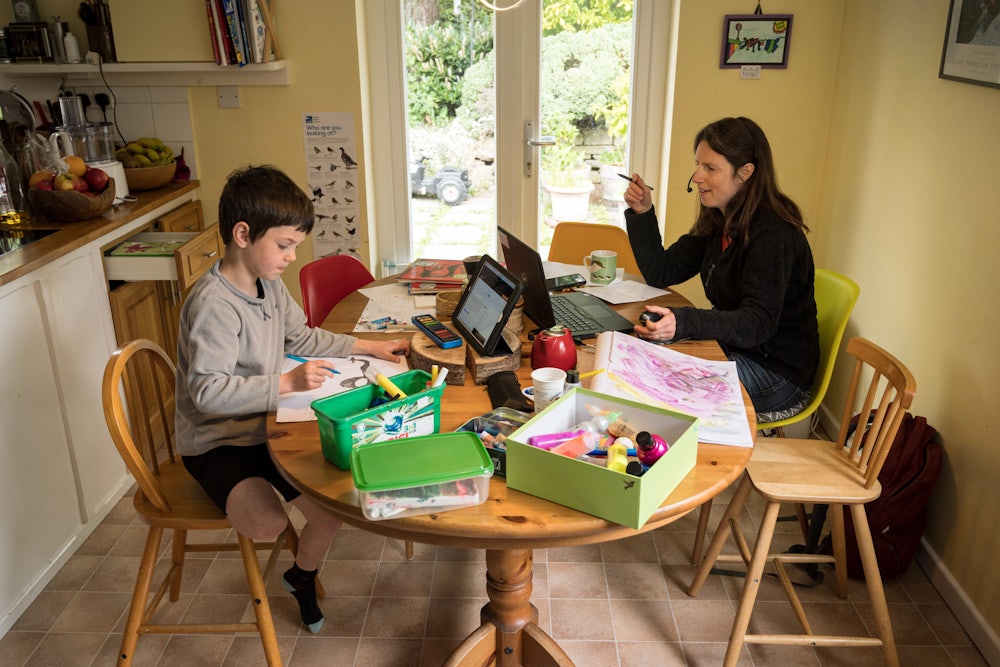The workplace panopticon is coming home. The societal shift to work from home and Zoom-led education has been a boon for makers of digital surveillance software. Numerous apps now sell themselves as proctoring tools that track student eye movements, while similar products ensure that workers aren’t playing games when they should be laboring in a spreadsheet. These “productivity tools”—with Orwellian names like DeskTime, SPYERA, Time Doctor, and Hubstaff—have exploded in sales amid the pandemic, while largely remaining under the public radar.
But now Microsoft is expanding its own worker surveillance business, marrying sophisticated data collection with ratings of worker productivity. Our work-from-home lives may never be the same.
The tech giant recently announced the wide availability of Productivity Score, declaring, “As leaders, it’s our job to make sure people have the tools they need to do their best work. But tools alone are not enough—you also need to help everyone in your organization build the habits that harness the true power of those tools. Until now, it’s been difficult for leaders to get insight into these habits and understand how to help people make the most of the technology they invest in.” (Their emphasis, of course.)
The score is a feature within Microsoft 365’s Workplace Analytics, which the company advertises as a way for employers to “harmonize productivity and well being,” “enhance organizational resiliency,” “transform meeting culture,” and “increase customer focus.” Critics and labor advocates say this all amounts to an invasive method of monitoring and cataloging worker behavior, producing inscrutable metrics and forming databases that may be used for union-busting or to tilt the playing field toward employers during annual reviews. (While Workplace Analytics can be used to collect anonymized data, by default it collects individualized user data.)
Esoteric metrics based on analyzing extensive data about employee activities has been mostly the domain of fringe software vendors. Now it's built into MS 365.
— Wolfie Christl (@WolfieChristl) November 24, 2020
A new feature to calculate 'productivity scores' turns Microsoft 365 into an full-fledged workplace surveillance tool: pic.twitter.com/FC3N6KkIR3
Workplace Analytics is included in Microsoft 365, the office suite that tens of millions of workers use every day to write memos, calculate earnings, or send emails. All of that behavior—all the hundreds and thousands of tiny constituent actions that make up a day of digital labor—can be captured and analyzed by employers for trends and best practices. A dashboard tells the story, offering graphs and metrics for monitoring communication, meetings, content collaboration, teamwork, and other categories of interest that comprise what Microsoft calls “people experiences.”
These metrics are then weighted alongside what Microsoft calls “technology experiences”—the quality of network connectivity, for example—in order to produce the Productivity Score, which is a single number, from 0 to 800, representing the employee’s or organization’s effectiveness. Scores can be measured across a company or compared to those of competing organizations. “Recommended actions” offer suggestions for how an employee or organization might improve performance.
Whether any of this tracking and scoring actually offers real insight—rather than obscure metrics that don’t actually measure real-world productivity—is almost secondary to the fact that it’s now embedded in the tools used by millions of people every day. Its presence, and potential profitability as a bountiful source of granular personal data, means that Microsoft is incentivized to sell Workplace Analytics as a work-from-home solution. Whether Microsoft can hone a people-centered, scientific, analytical platform here—or whether it’s so much apophenia, finding patterns and meaning where there may be none—is mostly a matter of salesmanship. If managers see the magical numbers on the dashboard going up (and can tell their managers that), who’s to say that Workplace Analytics doesn’t work, much less that it violates worker privacy, autonomy, and trust?
The platform’s ultimate efficacy depends partly on how workers will respond to knowing that they’re constantly being monitored and assessed. Will they endeavor to “hack” their productivity scores, perhaps by repeating behaviors that they know are favored by the system measuring them? Will employees, when granted permission to check their own scores, compete with one another or experience declines in morale if they find out they have a low score? And what does it mean for the future of worker autonomy to know that every action feeds into an all-seeing system over which workers have no control? (For those few white-collar workers in unions, questions of surveillance should be front and center in future collective bargaining discussions.)
Across the economy, disruptions from the pandemic have caused employers to embrace new surveillance techniques, from wearable devices to daily symptom checks. By touting its expansion into the work-from-home market, Microsoft’s Workplace Analytics product demonstrates the natural, if troubling, progression of that practice. It also offers an important reminder of how deeply surveillance is intertwined with our digital ecosystem. While Workplace Analytics offers new capabilities for nosy managers, it’s also emblematic of a powerful economic logic undergirding surveillance capitalism: that all this human behavioral data is being created anyway, so we might as well collect it and try to derive something useful from it. To employers, that may seem like a valuable opportunity. But it will expose workers to yet another opaque system that may affect their pay or professional standing. This is not harmony: It’s an existential threat.
